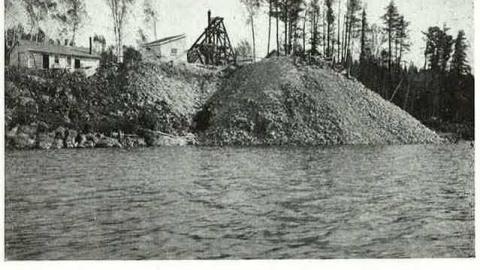About this location
Wil be updated with recent pics soon.
DESCRIPTION Source: Forty-sixth annual report of the Ontario department of mines, Vol XLVI, Part 1, 1937
The Smith Thorne group, which comprises over 60 claims, is situated in the southern part of Horwood Township on both sides of Horwood Lake. This group was taken under option by the Hollinger consolidated Gold Mines, Limited, in 1935 from the original owners, W. Smith and T. A. Thorne. Visible gold had previously been discovered in quartz veins on each group. Mining operations which were commenced in September, 1935, have been confined almost entirely to the Smith group situated on the east shore of hardwood lake, just south of Hardiman bay. The rocks here consist mostly of dark-weathering Keewatin lavas, which include ellipsoidal and amygdaloidal types of andesites and basalts. They strike northeast and dip from 45° to 50° N.W. They are cut by masses of Algoman quartz-feldspar porphyry, most of which are linear in shape and strike parallel to the lavas. A few cut across the strike of the lavas at small angles.
Shaft sinking was commenced in the fall of 1935 for the purposes of exploring a gold bearing quartz vein, which dips about 45°N. and strikes N.80°E from the east shore of Horwood lake. By august 15, 1936, a 45 degree shaft, the upper part of which followed the vein, had been completed, most of it on the 570-foot level. By October 5, 1936, drifting on this level had disclosed the vein for a distance of 100 feet both east and west of the shaft. Vein widths varied from 2 ½ to 6 feet, and visible gold was exposed both in the shaft and on the 570 foot level. A vein section 75 feet in length on this level west of the shaft was reported to be of good grade of mineable width.
In addition to gold, the vein minerals include pyrite, chalcopyrite, pyrrhotite, galena, and zinc blend. Small grains and veinlets of an unidentified grey mineral of metallic luster when subjected to qualitative tests yielded antimony and arsenic, which suggested the presence of stibnite. Tourmaline and calcite are also present. During the early part of October, 1936, the drift west of the shaft had reached a fault, where the vein was lost, and exploration for a time was confined to drifting on the vein in the porphyry to the east. Later in 1936, underground diamond drilling was commenced with the object of locating the vein beyond the fault.
A well-defined gold quartz vein containing sulphides is exposed on the surface about 800 feet east of the shaft. Drag folds in the vein suggest that the rocks north of the vein moved relatively to the west. The strike and dip of this vein conform roughly to the strike and dip of the vein at the shaft. Additional work, however, will be necessary before their exact relationship can be established.


